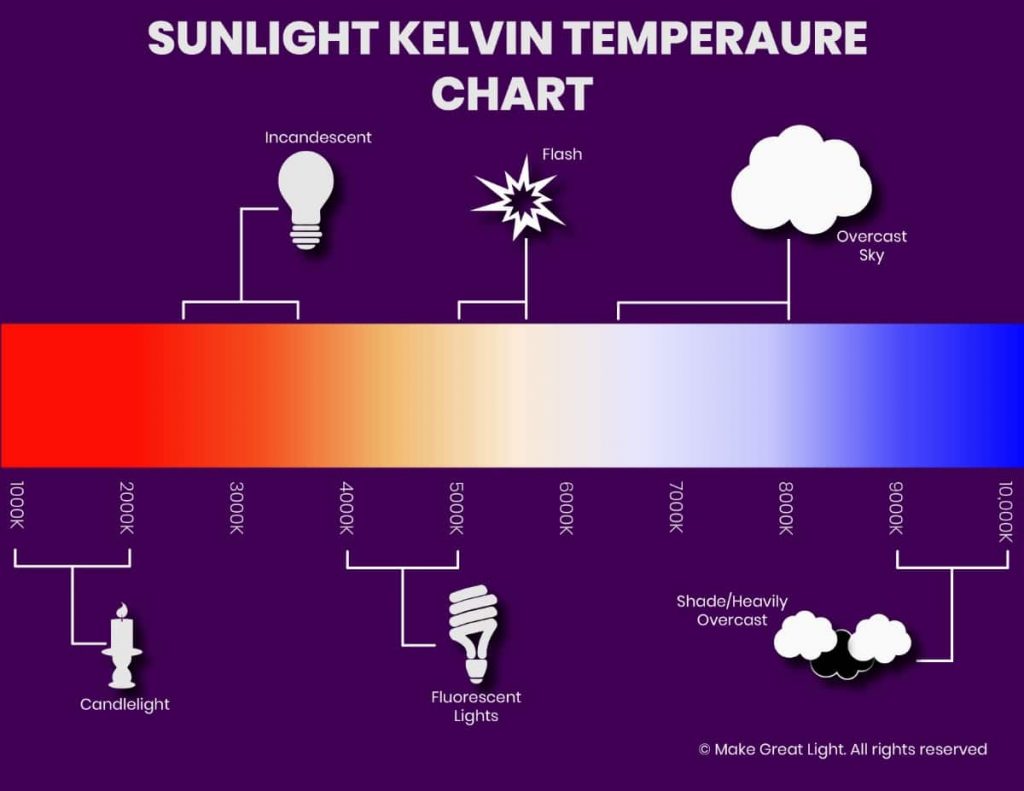According to research, the average office worker spends almost 1,700 hours per year in front of a computer screen – 6.5 hours per day. Not only is this damaging to the eyes (researchers found that fluorescent lighting may increase the incidents of eye disease by up to 12 percent) but being indoors beneath fluorescent lights for hours each day has other health risks as well.
In fact, a study conducted by Stony Brook University revealed that fluorescent lights emit dangerous UV rays that can damage the skin, and it’s well-documented that poor lighting causes headaches and reduces productivity in workers.
In today’s high-tech world, we are often glued to some kind of screen – whether it be the computer, a tablet, or smartphone – which means on top of those hours spent beneath artificial lights, we are also spending less time outdoors. The result? Not enough full-spectrum light.
Table of Contents
What is Full-Spectrum Light?
The best example of full-spectrum light is sunlight, although it can vary depending on the time of day and conditions.
Light is measured by color temperature and Color Rendering Index (CRI). The CRI measures how naturally a light source shows object colors. If you take an object from your home or office outside, it will look different than when it is inside because it is being touched by full-spectrum light.
All living things benefit greatly from full-spectrum light and it is a necessary component for the survival of people, animals, and plants.
So how do you know if you and your staff are getting enough full-spectrum light?
Essentially, not getting enough full-spectrum light results in a deficiency in Vitamin D which affects nearly half of the global population. Here are some signs to look for.

Short Term Effects
Frequent sickness
If you or your employees experience frequent sickness, it could be because of the lighting in the office. Vitamin D – which you can get from full-spectrum light – is an important part of the body’s immune system and a lack of it can result in increased illness and, consequently, absenteeism.
Depression/Low Morale
Research has frequently found that lighting has impacts on people’s moods. In fact, some research has shown that poor lighting can actually induce hostility, so if you’re seeing some workplace conflict, it could be the result of your lighting.
Those that live in areas that receive lower amounts of sunlight in the winter can be prone to developing Seasonal Affective Disorder (S.A.D.).
Fatigue
Exposure to too much fluorescent light has been shown to increase fatigue and disrupt sleep quality, so if you or your staff are experiencing low energy and fatigue, you may not be getting enough full-spectrum light.
In addition, working under incandescent bulbs can alter our circadian rhythms, the physiological internal natural clock that lets us know when it’s time to get some sleep.
Melatonin is a hormone in the body that is important in the role of sleep. When it’s dark, melatonin production increases and when it’s light, it decreases.
Columbia University explains that brighter lights help to reduce the production of melatonin, such as is used with light therapy.
Chronic Back Pain
Obviously, sitting at a desk for too long (or too often) is rough on a person’s back alone. But add in a lack of full-spectrum light and you increase your chances of developing back and bone pain. For women, the risk is actually increased.
Some individuals might mistake “bone pain” for something like arthritis or fibromyalgia because the pain sensations are similar, but not getting enough full-spectrum light can cause identical symptoms.
Impaired Healing
If you or a staff member has had a recent surgery or accident, a lack of vitamin D will result in slow healing, especially in wounds of the skin.
Excessive Sweating
Even if you have A/C and comfortable room temperature, people with a Vitamin D deficiency are known to experience excessive sweating. So if you, your office workers, or staff are experiencing unusually high levels of sweat, the culprit could be the lighting.
These are just some of the signs you’re not getting enough full-spectrum light. There are other risks associated with insufficient or improper lighting that may not have immediate symptoms but have serious long-term effects.
Long-Term Effects
Employees are the most important part of any organizational success, but when they (or you) are subjected to insufficient lighting through their careers, the long-term effects can be life-altering and even life-threatening.
Heart Disease
For both men and women, a vitamin D deficiency can increase the risks of heart disease, which is responsible for one in every four deaths in the US every year, according to the CDC.
Cancer
There have been numerous studies that reveal that Vitamin D deficiencies can increase the risks of colon and other types of cancers. Ultraviolet Rays (UV) rays from fluorescent lights can not only increase risks for cancer but also irritate existing conditions and promote premature skin wrinkling and aging.
Premature Death
Believe it or not, science has found that adequate vitamin D intake is associated with lower mortality rates. This suggests that a lifetime (or career) of working beneath improper or unhealthy lighting can contribute to premature mortality.
What To Do

If you are seeing any of these symptoms, there are many things you can do to ensure that you and your staff/faculty/employees are getting the right amount of full-spectrum light.
Hold Outdoor Meetings
Meetings are a necessary evil in the business world, but just because you need to hold those meetings, doesn’t mean they should be confined to a conference room or boardroom. Heading outside means not only creating a more casual space for innovation and brainstorming. Beyond that, though, a walk outside provides the suggested 10 to 15 minutes of sun exposure – even on overcast days – that our bodies need.
Add Nature to the Office
Research has steadily indicated that having plants in the office creates a more soothing, natural environment. But there is another way you can utilize office plants and foliage to ensure your office has enough sunlight.
In short, if you have office plants that are wilting or showing signs of ill health despite regular care, chances are they are not receiving enough sunlight (or, they might not have enough Vitamin D available in their soil). This is a great way to identify whether or not your office (and you and your staff) are receiving enough full-spectrum lighting.
Provide Outdoor Eating Areas
Office workers need to eat, too, and one way to take in some valuable rays from the sun is to provide the opportunity for workers to have their lunches (or snack breaks) outdoors. This is an economical and easy way to encourage them to get outdoors.
Provide Dietary Options
Certain foods are high in Vitamin D. By offering staff and workers options such as cheese, orange juice, or tuna, you are providing them with the opportunity to ingest their intake of Vitamin D.
Educate Workers
Providing information to your employees about the ways they can increase their Vitamin D intake is a great way to ensure they understand the need to mind their diets and exposure to the sun.
Open the Windows
If you have no windows or small windows, chances are your office is not receiving enough sunlight. Consider replacing small windows or installing larger windows to allow for extra sunlight.
Encourage Outdoor Exercise
Chances are, you have at least a few employees who enjoy the outdoors. Encourage groups to take walks during the day – perhaps as part of their lunch routine – so they are able to soak up some of the sun’s valuable rays as well as bond together as colleagues.
Organize Special Get-Togethers
As with most outdoor activities, a company barbecue is not only a great way for colleagues to bond, but also to eat healthily and experience the great outdoors. As an informal get-together, employee barbecues will lift morale while also providing a great meal and exposure to sunshine.
Change the Lighting
One of the most cost-effective ways to reduce the effects of office lighting is to change the lighting.
In a survey conducted by the Rensselaer Polytechnic Institute that asked individuals with an above-average knowledge of lighting, the findings were remarkable.
They asked respondents to rate a number of factors related to full-spectrum lighting, including:
- Improves color perception
- Improves visual clarity
- Improves mood
- Improves productivity
- Improves mental awareness
- Improves retail sales
- Improves plant growth
- Improves results of light therapy in treating seasonal affective disorder (SAD)
- Improves results of light therapy for sleep disorders
- Improves scholastic performance of students
- Improves vitamin D synthesis in the body
- Reduces incidents of dental decay
Overwhelmingly, the respondents found full-spectrum lighting to improve every one of these things with the exception of dental decay.
However, not all full spectrum lighting is equal.
While some companies tout full spectrum lighting solutions, Make Great Light is about more than just providing a sensible solution for office and school environments.
Initially, Seasonal Affective Disorder (SAD) was the reason behind our partnership with NaturaLux™ to bring relief to those suffering from the disorder. Light therapy has long been used to treat this disorder as well as other disorders such as jet lag and sleep disorders.
However, combining his knowledge of vision and color photographic darkroom technology, NaturaLux™ inventor, Kevin Kirschner, was able to develop a truly unique resolution that not only helps with existing conditions but improves the overall productivity, mood, and operations of office and organization workers.
Compared to the cost of replacing the entire lighting system in your facility, applying fluorescent filters is a much more economical way to improve your lighting.
Sources:
https://pubmed.ncbi.nlm.nih.gov/pubmed/27222384
https://www.livestrong.com/article/519173-vitamin-d-excessive-sweating/
https://www.entrepreneur.com/article/245848
https://pubmed.ncbi.nlm.nih.gov/pubmed/19193916?dopt=Citation
https://www.cdc.gov/heartdisease/facts.htm
https://www.makegreatlight.com/benefits/eliminate-uv-radiation-with-uv-light-filters
https://www.makegreatlight.com/about-us/blog/lupus-photosensitivity-fluorescent-lighting
https://pubmed.ncbi.nlm.nih.gov/pubmed/17846391?dopt=Citation
https://www.health.harvard.edu/staying-healthy/time-for-more-vitamin-d
http://www.all-science-fair-projects.com/print_project_1424_50
https://www.healthline.com/nutrition/9-foods-high-in-vitamin-d
https://www.fastcompany.com/3015694/way-beyond-a-company-bbq-how-to-truly-improve-employee-morale
https://www.mayoclinic.org/tests-procedures/light-therapy/about/pac-20384604
